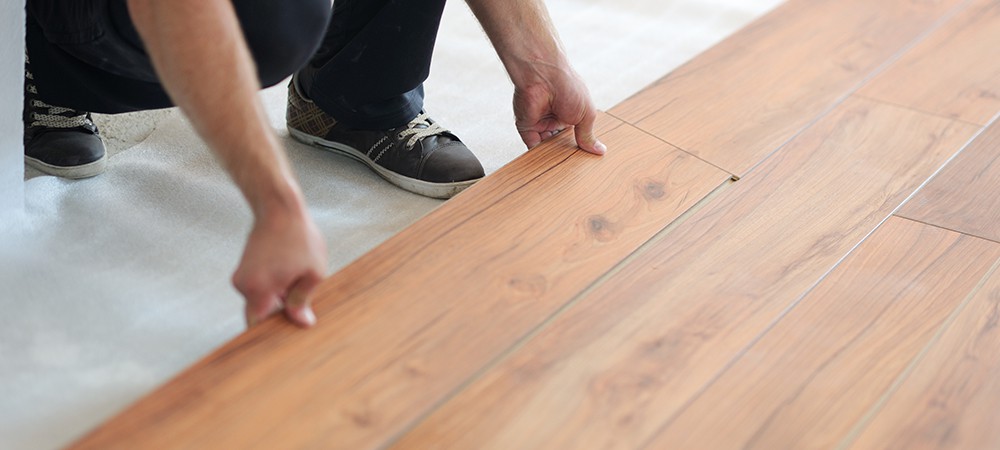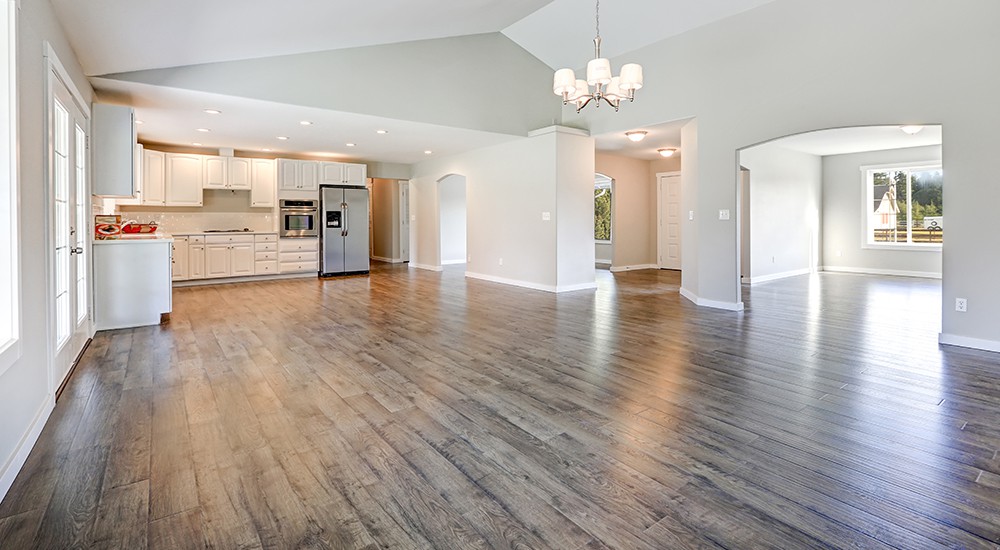Choosing the right flooring option for your home can be challenging, especially when you’re on a budget. The go-to flooring options nowadays are hardwood, stone, and tile flooring. And of the three, many people now prefer solid or engineered hardwoods for their floors. But there’s an excellent alternative to these flooring options in laminate flooring.
Hardwood floors are an excellent addition to the interior decor of a house. They add warmth, charm and elegance to the space. So, it’s not surprising that several people prefer this flooring option for their homes. Unfortunately, hardwood floors are difficult to install, expensive and challenging to care for. The same applies for stone and tile floors.
Laminate flooring provides similar effects to the three common types of flooring. You can add all the warmth and character of hardwood floors to your space without installing hardwood.
All you need is the right design of laminate flooring in your home. But before you go ahead to do it, you should know the pros and cons of laminate flooring.
We’ll get into it shortly. But before diving into the advantages of laminate flooring, let’s establish a comprehensive background into this flooring option.
Review of Laminate Flooring
Laminate flooring is a type of composite synthetic flooring designed to mimic the feel and look of natural building materials. Laminate flooring isn’t just another cheap rip-off of wood floors. Rather, they are specifically designed as beautiful, strong and cost-effective alternatives to natural flooring materials.
They’re constructed by laminating several layers of fibreboard materials together to create a semblance of a plank. The plank sometimes also includes a backing layer or underlayment on its bottom to provide extra protection.
To mimic the character of wood floors, a printed image layer is pressed to the top of the core at high temperatures. This surface layer features vinyl material with a realistic image of wood floors. Not only that, but it also mimics the texture and grains of wood floors.
Each layer of the laminate floor plank has a specific contribution to the integrity of the whole. The core layers absorb shock and pressure, while others like the top layer are for decorative appeal. It also has a thin layer of transparent plastic to protect the other layers from damage.
Note that the materials used for laminate flooring mostly don’t contain any wood. Instead, manufacturers use synthetic materials.
Occasionally, the manufacturers may add a little bit of wood chip as a component, but it’s not a common practice. Now back to the question, what are the pros and cons of laminate flooring? Let’s start with the pros.
Pros of Laminate Flooring
There are several benefits to installing laminate floors in homes. For context, you’ll hardly find a flooring material with great value at a relatively low price, like laminate. There are many more benefits to installing laminate flooring in your living space; we discuss them below.
Super Durability
We can’t overstate the durability of laminate flooring when considering its pros and cons. Laminate floors are built to last!
Most, if not all, homeowners want to invest in flooring options that’ll still be in excellent condition several years down the line. Do you want something that can weather high traffic with little to no damage? Then, laminate flooring is a perfect option for you.
Laminate floors have a standard lifespan of 15 to 25 years with proper maintenance and care. The core layer of the laminate planks does a great job of absorbing stress and pressure.
This makes it suitable for high traffic areas. You also don’t have to worry about fading or discolouration. The uppermost layer of the floor offers excellent protection against UV and electrical light that cause floor bleaching, staining or cracking.
We’ll put laminate flooring in the same category as porcelain tiles and EVP flooring in terms of scratch resistance. The good part is, laminate flooring allows you to achieve the looks and feel of beautiful wood floors in your apartment.
Wood floors like douglas fir and pine are lovely, but they scratch easily. However, you get their looks and a great deal of scratch resistance with laminate floors.
Realistic Designs
Another prominent advantage of laminate flooring is the variety of design options it gives you. Unlike most natural building materials, laminate’s style options don’t end with colours.
Instead, it offers a vast selection of natural-looking wood, tile and stone designs. The sweet part is each of the three options still offers a more extensive array of patterns that the laminate floor can adopt.
Furthermore, the designs are so realistic; you’ll barely be able to tell the difference. As noted earlier, the manufacturers achieve the near-perfect look using hyper-realistic images of the desired material.
They’ll print the images on a vinyl material which they’ll then laminate to the surface of the planks before putting on the scratch and stain-resistant top layer.
In addition, laminate planks create a solid base that can complement any interior decor scheme. Whether light and airy, rich and dark or something in-between, there are laminate planks that’ll match the style.
You can even find laminate flooring options already spotting design patterns like the herringbone parquet. Your design options are near-limitless with laminate flooring.
Cheaper Alternative to Hardwood
Laminate flooring gets the advantage in the price discussion when considering its pros and cons compared to hardwood.
Simply put, laminate flooring is way cheaper than hardwood floors. It’s much more budget-friendly while providing the look and feel of the real material.
Most people come to learn of laminate flooring when looking for cheaper alternatives to hardwood floors. It’s a product of synthetic and composite material pressed together at high temperatures. So, it’s a lot cheaper to create than it is to obtain natural timber, especially those of exotic species.
For context, you can get laminate flooring for as low as $2 per square foot, while most hardwood brands cost nothing less than $15 per square foot. It’s the perfect option for budget-conscious homeowners. Of course, you can also go for it if you’re looking to save money.
Easy Installation

Unlike many other flooring options, laminate floors are so easy to install, anyone can do it. You don’t need to be a DIY pro to put laminate floors together.
Most manufacturers design laminate planks to click/snap into position during installation. You simply need to put the plank edges together, and they’ll fit like puzzle pieces. And, in most cases, you won’t need glue or nails.
Nonetheless, you may need to do a little bit of pre-installation prep. It may sound like a point that should be under the cons, but the process is too easy, and it fits right with the pros of laminate flooring. You simply need to ensure the subfloor is flat and clean before putting the planks on it. The click-lock and dry glue design enable the planks to snap into place.
Laminate floors are straightforward to install; you can cover 300 square feet over the weekend. So if you’re interested in DIY flooring, laminate is a good option for you. However, before attempting DIY installation for laminate floors, ensure the DIY installation won’t void the warranty on the floors.
Easy Maintenance
Compared to hardwood, laminate floors are easy to clean and easier to maintain. First off, laminate floors are children and pet-friendly.
They feature a stain-resistant topcoat that protects against several sorts of spills. So, you can easily wipe up messes when they occur. In addition, the topcoat is scratch-resistant. And, the smooth surface of the floor offers no hiding places for dirt, dust and allergens.
With a hardwood floor, you’ll need to do constant refinishing, sanding etc., to maintain it. However, you don’t need any of that with laminate floors. In fact, it doesn’t require any specific regular maintenance practice; you only need to vacuum and mop it up every other day.
These are only a few of the reasons you should install laminate flooring. It’s also worth mentioning that it discourages deforestation as it has no need for timber like hardwood floors. So, by opting for laminate flooring, you’re playing your part in natural habitat preservation.
Related Article: What is Wire Brushed Flooring?
Cons of Laminate Flooring
A review of laminate flooring will not be complete if we only examine the pros and ignore the cons. While the benefits of laminate flooring are significant, it also has a few demerits worth noting.
It Doesn’t necessarily Add To The House’s Value
Laminate flooring may look, feel and even feature the warmth of hardwood, but it’s not natural wood. Homebuyers know this, and most times, they don’t want it.
They don’t like what they think is a cheap rip-off of natural hardwood. So, they’ll always go for the real deal over its mimicry. As such, you may not be able to get maximum profit when you sell off the house.
There’s no denying that laminate floors have several advantages over hardwood floors, but most homebuyers don’t care. They often prefer the ostentation of hardwood floors over the practicability of other options like laminate floors. To that end, laminate floors won’t have the same effect on your home’s resale value as real hardwood.
You Cannot Refinish Laminate Floors
Laminate floors cannot undergo refinishing procedures. In a way, this point can be both a pro and a con of laminate flooring, depending on how you look at it. You can refinish and retouch hardwood floors as many times as required to keep them looking fresh. You can do no such thing with laminate floors.
Again, laminate floors have a fibreboard core and a thin wood/stone-esque layer on top. Unfortunately, the top layer is too thin to handle refinishing procedures. As such, once the thin layer wears out, you’ll need to replace the entire floor or laminate plank.
The good news is; the thin layer doesn’t wear out as quickly as the top of hardwood floors. It’s durable, scratch-resistant and can handle high traffic. So, you don’t need to worry about refinishing as long as you take proper care of your laminate floors.
It’s Susceptible To Moisture Damage
Being stain-resistant doesn’t imply that it’s also moisture resistant. Most people tend to confuse these seemingly similar points when considering the pros and cons of laminate flooring. Regardless, always keep in mind that most laminate floors are not resistant to liquids.
The high-density fibreboard material that makes up the laminate planks core is highly susceptible to water damage. Unlike natural wood, the HDF expands and breaks down on exposure to water. When that happens, the laminate floor plank loses its core which compromises its integrity. As such, you’ll need to replace it.
Interior designers often advise homeowners against installing laminate floors in areas with high exposure to moisture. However, in response to that, manufacturers are now developing water-resistant laminate options. That’s an excellent development, but the fact remains that most laminate floors’ cores can’t handle moisture exposure.
The water-proof laminate may hold well against water and prevent the liquid from getting to its core. However, most people will prefer to go with a flooring alternative that never had such a telling weakness in the first place.
Laminate Floors Tend to Be Hard and Slippery
Laminate floors are not always the most comfortable underfoot. Compared to carpet or rugs, laminate floors will feel like you’re walking on solid rock.
Although, using high-quality underlayment can increase the comfort of laminate flooring. Then again, when you compare laminate flooring to tiles, you’ll find that it’s still quite comfortable. So, it’s not all bad.
Furthermore, there’s also the issue with the level of friction laminate floors provide. Traditional laminate floors are rather slippery and often create much concern about their safety.
Fortunately, manufacturers are working on new designs that offer better grip. So, it’s a matter of time before this problem becomes non-existent.
Laminate Floors Make a Lot of Noise
Laminate floors perform poorly when it comes to noise absorption and cancellation. If you like to wear high-heeled shoes, the heels make a hollow sound on impact with the surface of the laminate floors. You may find the noise particularly annoying when walking on these floors. You’ll need to install an acoustic underlay to curtail the noise levels of laminate flooring.
Laminate Flooring is Not the Most Eco-Friendly Option
We understand this may be a bit confusing. We already mentioned in the pros that laminate flooring contributes to environmental preservation; now we’re saying it doesn’t? No, we’re not saying that. Laminate flooring reduces the need to take natural resources such as wood and stones out of the environment. And that contributes to environmental preservation.
However, laminate floors tend to release volatile chemicals over time like many other synthesized products. Through a process called off-gassing, laminate floors release harmful gases into the environment.
Of course, there are low-VOC laminate flooring options. But, unfortunately, there’s no such thing as non-toxic laminate flooring, at least not yet. Nonetheless, you can still go for laminate options that have been certified as safe to use.
Laminate Flooring FAQs

Below are answers to common questions about installing laminate flooring:
Where Can I Install Laminate Flooring?
Traditionally, laminates are restricted to areas with low exposure to moisture. This is due to its inability to cope well under such conditions. However, many laminate designs nowadays are suitable for most indoor spaces. Plus, they’re durable and can handle high traffic. So, you can install them in your living room, dining and even kitchen.
Nonetheless, ensure to confirm with the manufacturer if the laminate floor is water-resistant or not before installing it in your kitchen. Laminate floors without sufficient moisture resistance will not hold out well in a kitchen environment. And don’t even consider installing them in a bathroom.
What Are the Important Things I Need Before Installing Laminate Floors?
You need to have several things in place before beginning laminate floor installation.
- First, ensure the subfloor is flat, smooth and dry.
- Then install an underlayment to soundproof the floor and make it more comfortable.
- Read the manufacturer’s manual carefully before installing laminate floors
- It’s also good to let the laminate floor panels acclimatize with the room before installing them. Ideally, you can store the planks in the room for 48 hours prior to installation.
- Carefully inspect each plank for defects or damage before installing them.
Related Article: How to Keep White Oak Floors from Yellowing
Final Thoughts
Laminate floors present beautiful, durable and cost-effective flooring alternatives for your interior decor designs. But of course, you should already know that after reading through all these pros and cons of laminate flooring.
We’ll advise you to weigh the pros and cons carefully to see if it’s the right option for you or not. Don’t rush to a decision; consider your alternatives meticulously.
That said, if laminate flooring sounds right for your home, check out our online store for beautiful laminate flooring designs. If you can’t find what you like, feel free to reach out to our flooring experts at LV Flooring and let’s help you find what you want!


